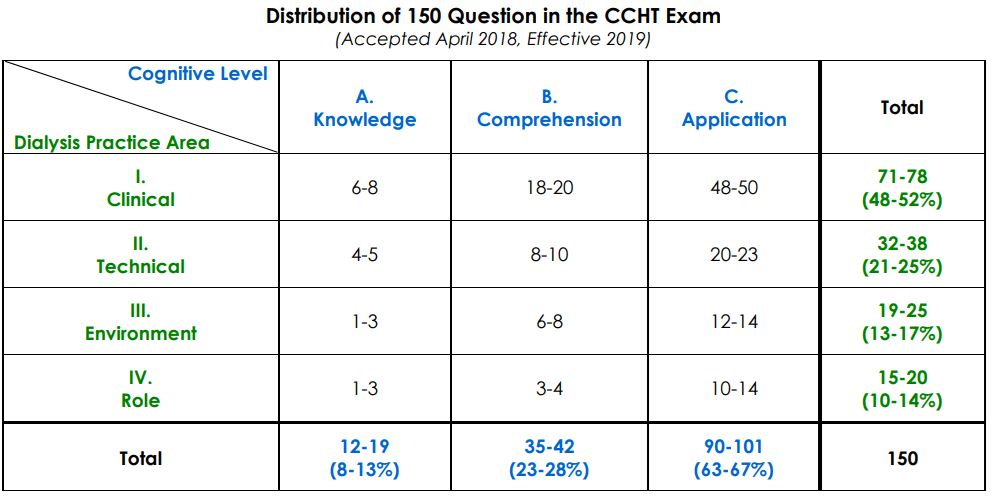Last Updated on June 14, 2025
FREE CCHT Practice Test 2025 Official Study Guide [PDF]. The Nephrology Nursing Certification Commission (NNCC) administers the Certified Clinical Hemodialysis Technician (CCHT) certification. The Clinical/Technical Examination Board is made up of representatives from the CCHT and CCHT-A Test Committees.
The CCHT is the nationally recognized entry-level certification for U.S. dialysis technicians. It is awarded by the Nephrology Nursing Certification Commission (NNCC). It verifies that the holder can safely perform the clinical, technical, safety, and communication tasks required in routine outpatient hemodialysis care.
CCHT Practice Test 2025
Try our free CCHT Practice Tests. The official test consists of 150 questions that match the test blueprint. About 25 of the questions are new experimental or “pilot” questions that are not scored. The passing score of the test is determined by a panel of technicians who serve as subject matter experts (SMEs). A score of about 74% correct is required to pass the CCHT examination.
Eligibility
To be eligible to sit for the CCHT Exam, you must:
| Requirement | Typical expectation |
|---|---|
| Education | High school diploma or GED |
| Training/Experience | Completion of an approved hemodialysis technician course or roughly 6 months of clinical dialysis employment (suggested minimum 1,000 hours) |
| Regulatory compliance | Meet your state’s hemodialysis-technician training mandate and have an unencumbered status (no disqualifying disciplinary actions) |
| Fees (2025) | Application + exam: about USD 225 (paid to NNCC/PSI) |
Exam Format
The CCHT examination is designed to assess the knowledge required to provide safe care to patients undergoing hemodialysis treatments. There are also three Cognitive Levels: Knowledge, Comprehension, and Application.
There is no limit to the number of times you can take the exam. If you are unsuccessful on the exam, you may reapply by submitting a new application by mail.
| Feature | Detail |
|---|---|
| Format | Computer-based, 150 scored multiple-choice items + 15–20 unscored pilot items |
| Time | 3 hours |
| Blueprint distribution |
|
| Cognitive levels | Knowledge, Comprehension, Application (about two-thirds of the test is application-level) |
| Passing Score | Determined by a scaled score (typically ~70%) |
| Passing standard | Criterion-referenced cut score set by psychometric panel; pass/fail shown immediately at the test center. |
CCHT Exam Content Areas
Several different types of questions appear on the CCHT examination. Some questions require a basic recall of knowledge, while others test the technician’s ability to comprehend a concept. Most of the questions ask the technician to apply knowledge in a clinical situation.
| Section | % of Exam | Description |
|---|---|---|
| 1. Clinical | 48–52% | Covers pre-, during, and post-dialysis care (e.g., patient assessment, cannulation, vital signs, response to complications) |
| 2. Technical | 21–25% | Covers water treatment systems, machine alarms, extracorporeal circuit, dialyzer setup, and technical troubleshooting |
| 3. Environment | 13–17% | Infection control, body mechanics, chemical spills, PPE use, and environmental safety |
| 4. Role Responsibilities | 10–14% | Communication, professional boundaries, confidentiality, teamwork, documentation, and patient advocacy |

How does it differ from other U.S. dialysis tech credentials
Below is a quick-reference guide to how the NNCC Certified Clinical Hemodialysis Technician (CCHT) compares to other nationally recognized certifications in the U.S. credentials a dialysis technician might hold.
| Feature | CCHT (NNCC) | CHT (BONENT) | CCNT / CBNT (NNCO) |
|---|---|---|---|
| Focus | Direct patient care | Patient care (broader test) | Clinical or biomedical track |
| Experience to sit | Course or ~6 mo | ≥12 mo | ≥12 mo |
| Renewal | 3 yrs / 45 CE | 4 yrs / 40 CE | 4 yrs / 40 CE |
Official Study Guide [PDF]
The Online Practice Test (found on www.nncc-exam.org) has 50 multiple-choice questions available in two modes:
Practice Mode: provides the correct answer and rationale after each question
Test Mode: holds the results until the end of the test
